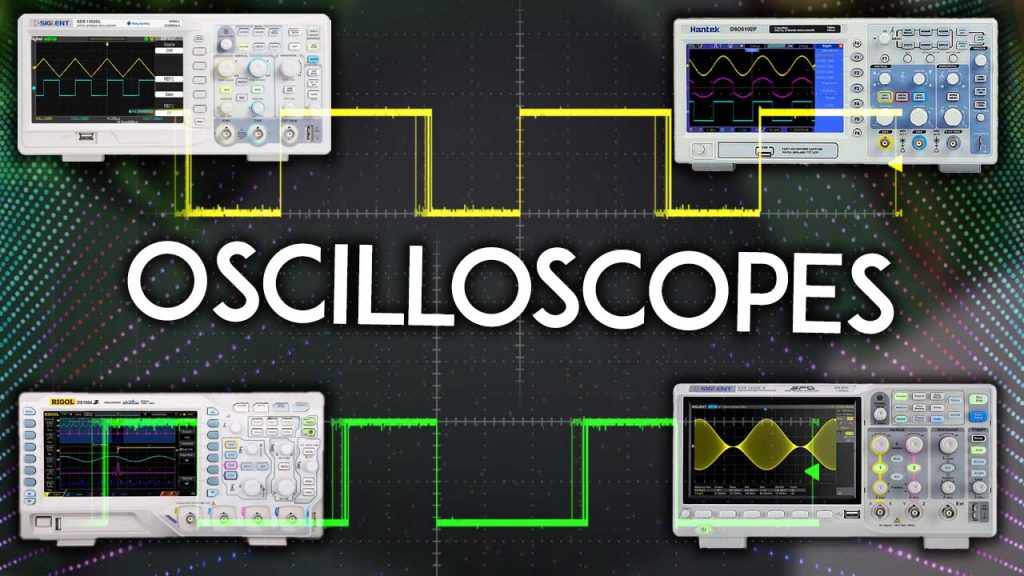
Are you looking for an oscilloscope for your electronics workbench? In this article, we’ll show you how to select the best oscilloscope to suit your requirements, whether you’re a beginner, electronics hobbyist, or maker.
Best Oscilloscopes for Hobbyists Comparison Table
Here’s a table comparing a selection of some of the best oscilloscopes for hobbyists.
Scope Model | Hantek DSO5102P | Hantek DSO4102C | Rigol DS1054Z | Siglent Technologies SDS1052DL | Siglent Technologies SDS1202X-E |
|---|---|---|---|---|---|
 | 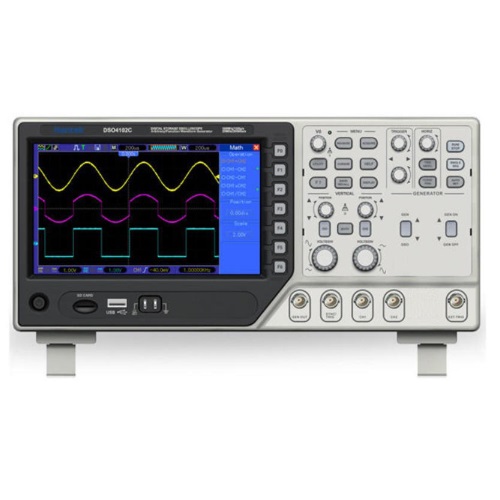 |  |  |  |
|
Where to Buy | |||||
Display | 7 inch TFT display | 7 inch TFT display | 7 inch TFT display | 7 inch TFT display | 7 inch TFT display |
Channels | 2 analog + ext | 2 analog + ext | 4 analog | 2 analog + ext | 2 analog + ext |
Bandwidth | 100 MHz | 100 MHz | 50 MHz | 50 MHz | 200 MHz |
Sampling rate | 1 GSa/s | 1 GSa/s | 1 GSa/s | 500 MSa/s | 1 GSa/s |
Time base | 4 ns/div to 40 s/div | 4 ns/div to 40 s/div | 5 ns/div to 50 s/div | 5 ns/div to 50 s/div | 1 ns/div to 100 s/div |
Capture rate | 2000 wfms/s | 2000 wfms/s | 30000 wfms/s | 100000 wfms/s |
|
Memory depth | 40 kpts | 40 kpts | 24 Mpts | 32 kpts | 14 Mpts |
Vertical resolution | 8-bit | 8-bit | 8-bit | 8-bit | 8-bit |
Vertical scale | 2 mV/div to 10 V/div | 2 mV/div to 10 V/div | 1 mV/div to 10 V/div | 2 mV/div to 10 V/div | 500 uV/div to 10 V/div |
Rise time | 3.5 ns | 3.5 ns | 7 ns | 7 ns | 1.8 ns |
AUX output | X | ✓ | X | X | X |
USB device | ✓ | ✓ | ✓ | ✓ | ✓ |
USB host | ✓ | ✓ | ✓ | ✓ | ✓ |
LAN | X | X | ✓ | ✓ | ✓ |
Extras | optional VGA | SD card support, waveform generator (25 MHz) |
Keep reading this article to take a detailed look at each of the selected scopes and find out how to select an oscilloscope that meets your needs.
How to Select an Oscilloscope?
An oscilloscope is a tool that allows you to see how voltage changes over time. It is handy to check electronics circuit operation, analog signals, PWM signals, debugging circuits, etc. To select an oscilloscope, you need to know what kind of signals you’ll need to measure. That will determine the specifications you’ll look for in an oscilloscope.
For example, you need to have an idea of how many signals you’ll need to measure at once; what is the maximum frequency and the maximum amplitude of the signals you’ll measure; if you’ll measure periodic signals, or if you’re looking for single shots.
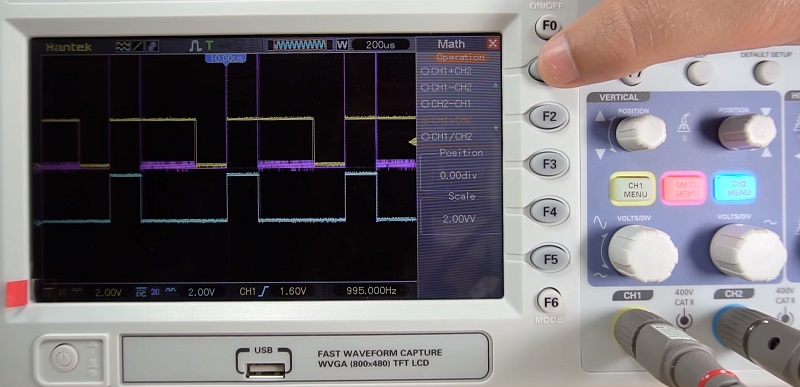
Here’s a list of the most important things to have into account to select an oscilloscope:
- Bandwidth: this determines the frequency range in which the oscilloscope measures accurately in the display. As a rule of thumb, you should select a bandwidth 5 times higher than the maximum frequency of the signals you’ll measure for more accurate results. For example, a 100MHz bandwidth is more than enough for most hobbyist circuits.
- Sample rate: this refers to how many samples per second the oscilloscope takes. The higher the sampling rate, the more accurate the results for faster signals. A higher sampling rate ensures you’re able to detect intermittent events.
- Number of channels: for entry-level oscilloscopes, it’s common to see 2 and 4-channel scopes. Adding more channels adds to the price. For a hobbyist, a 2-channel scope is usually enough.
- Price: the price is a critical aspect, as it will determine how much you can spend on a scope. There are great entry-level oscilloscopes around $250. However, if you don’t have such an amount of money to spend on this tool, you can always get a toy oscilloscope or a DIY kit to analyze basic circuits. There are also great alternatives for USB oscilloscopes or portable oscilloscopes like the Hantek 3 in 1: Oscilloscope, Multimeter, and Signal Generator (2D72).
Hantek DSO5102P USB Digital Storage Oscilloscope 2 Channels 100MHz 1GSa/s
In my opinion, the Hantek DSO5102P is one of the best entry-level oscilloscopes you can get for such a price. It has a 100MHz bandwidth, a sample rate of 1G samples per second, a record length up to 40K, and a dual channel. Additionally, the USB port allows you to connect a USB drive to save pictures of the signals. You can also connect it to your computer and use the software provided to analyze your measurements in more detail.
The scope is straightforward to set up, and the menus are intuitive to use, which is perfect for beginners. For a more in-depth look at this oscilloscope, you can watch the video review below or read here: Hantek DSO5102P Digital Storage Oscilloscope (DSO) review.
You can get this scope at a slightly lower price on Banggood. Just click the product card below.
Hantek DSO4102C Digital Multimeter Oscilloscope USB 100MHz 2 Channels LCD Display Waveform Generator
$325.23 out of stock
The Hantek DSO4102C has all its specs similar to the Hantek DSO5102P. But it adds an auxiliary channel to generate arbitrary/function waveforms.
Rigol DS1054Z Digital Oscilloscope - 50 MHz Bandwidth and 4 Channels
Rigol is a great brand of oscilloscopes and other measurement tools. So, when you pick a Rigol oscilloscope, you know you’ll get a piece of high-quality equipment. This specific model is one of the most best-selling oscilloscopes in the world.
It comes with 4 channels and offers 50 MHz bandwidth. It also comes with a USB connector, LAN(LXI) (you can connect an Ethernet cable), and AUX Output. This is a great oscilloscope when you take a look at price/performance.
Siglent Technologies SDS1052DL+ 50 MHz Digital Storage Oscilloscope
For under $300, the DSD105DL+ from Siglent technologies can be a great option. When it comes to its specifications, it features: 50MHz bandwidth, sampling rate of 500Msamples/s, dual channel, interface via USB, USB host, and LAN.
Another great scope from Siglent Technologies is the SDS1202X-E that offers 200MHz bandwidth, two channels, a sampling rate of 1GSample/s, and much more. Visit the product page for more details.
Toy Oscilloscopes and Oscilloscopes DIY Kits
If you can’t afford a “real” oscilloscope, there are DIY kits and toy oscilloscopes that may help you with your circuits. Obviously, these tools are not as accurate as a real oscilloscope and don’t have all the fancy mathematical functions, but still, they can do a great job.
One of the best options is the DSO150 digital oscilloscope. This is an elementary scope with a single channel, 200kHz bandwidth, and 12-bit resolution, and it only costs about $25. This tool doesn’t replace a real oscilloscope, but it is good enough for hobbyists looking to debug circuits where accuracy is not mandatory. Also, this can be a great tool for learning purposes. Watch our video review (or read our review).
Another alternative is the DSO138. Its specs are similar to the previous scope: single-channel, 12-bit resolution, 200kHz bandwidth. However, this scope is a DIY kit. But, you can also get it already assembled inside an acrylic housing. Personally, I prefer the previous scope because the controls seem more intuitive to use. However, it is just a matter of preference.
Portable Oscilloscopes and USB Oscilloscopes
Other cheaper alternatives include portable oscilloscopes and USB oscilloscopes.
Portable oscilloscopes look like multimeters but come with all the controls needed to visualize, analyze and record signals. One great option is the Hantek 3 in 1: Oscilloscope, Multimeter, and Signal Generator (2D72). As the name suggests, it is a multimeter, signal generator, and oscilloscope in a single tool. The controls and menus are not as intuitive as a regular oscilloscope, but it does a great job and occupies much less space. You can watch the following video review about this tool.
The USB oscilloscopes don’t have a display and usually don’t have controls—you connect them to your computer and control everything from software provided by the manufacturer. At the moment, we don’t have any in-depth reviews about USB oscilloscopes, but the Hantek 6022BE seems a good option.
Wrapping Up
In this article we’ve shown you some of the best oscilloscopes for electronics hobbyists and makers. Our number one pick for beginners and hobbyists is the Hantek DSO5102P Digital Storage Oscilloscope.

Hantek DSO5102P Digital Storage Oscilloscope - It's one of the best entry-level oscilloscopes when it comes to price/quality ratio.
However, all models presented are great oscilloscopes, and you won’t be disappointed whichever you chose. Remember that you should take into account your specific needs and select a scope with the right specifications.
For more information about a specific oscilloscope look for its datasheet online and you’ll find all the details.
You might also like reading:
- Hantek DSO5102P Digital Storage Oscilloscope (DSO) Review
- Hantek 3 in 1: Oscilloscope, Multimeter, and Signal Generator Review (2D72)
- JYETech DSO150 Digital Oscilloscope Review
- XR2206 Function Generator DIY Kit Review
- Best Bench Power Supplies
We hope you’ve found this buying guide useful. Do you already have an oscilloscope, or do you intend to buy one? Share your thoughts with us below.
Thanks for reading and don’t forget to subscribe our newsletter.
[Recommended Course] Learn ESP32 with Arduino IDE
Register in our brand new ESP32 course with Arduino IDE. This is our complete guide to program the ESP32 with Arduino IDE, including projects, tips, and tricks! The registrations are open, so sign up now.

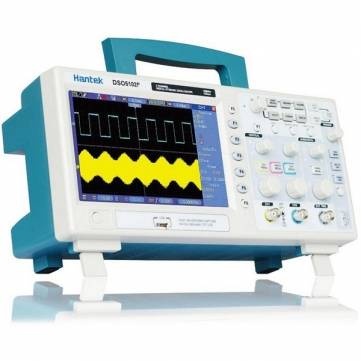



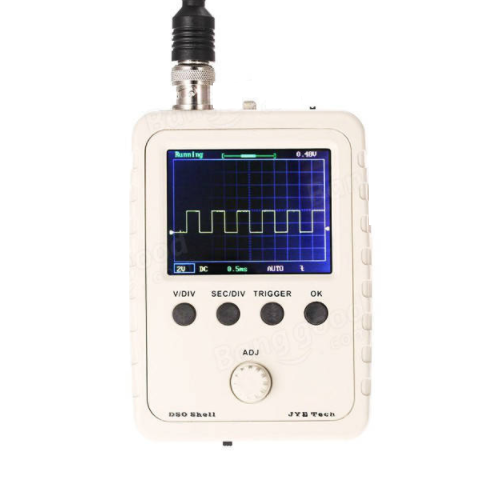
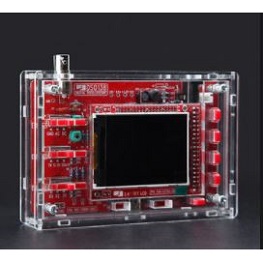
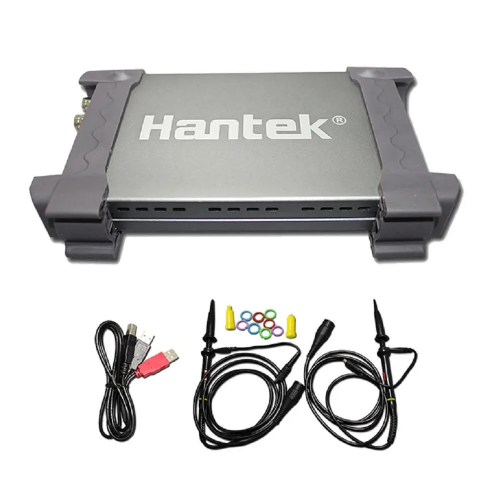

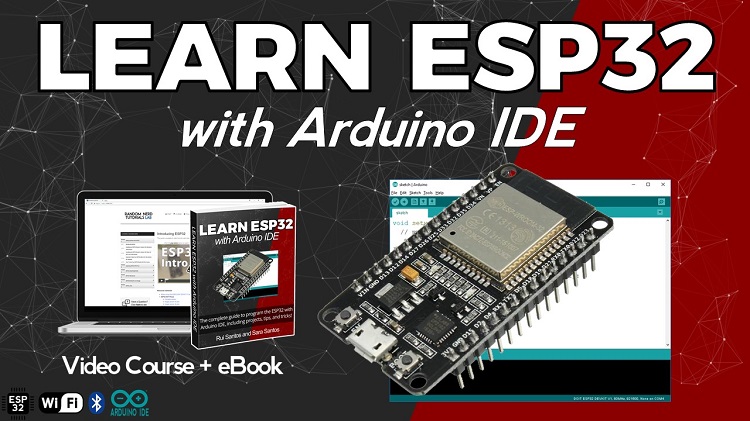
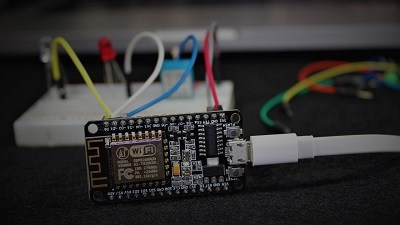 [eBook] Home Automation using ESP8266 »
[eBook] Home Automation using ESP8266 » [Course] Build a Home Automation System »
[Course] Build a Home Automation System » [Course] Arduino Step-by-Step Projects »
[Course] Arduino Step-by-Step Projects »
Leave a Reply